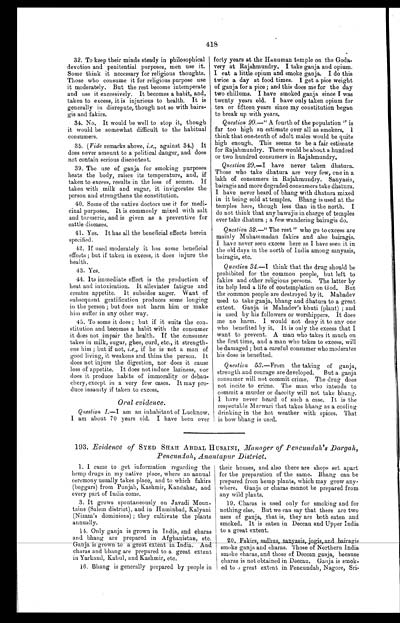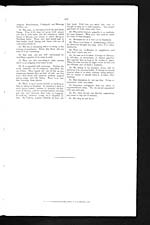Medicine - Drugs > Report of the Indian Hemp Drugs Commission, 1894-1895 > Volume VI > Evidence of Madras witnesses
(436) Page 418
Download files
Individual page:
Thumbnail gallery: Grid view | List view

418
32. To keep their minds steady in philosophical
devotion and penitential purposes, men use it.
Some think it necessary for religious thoughts.
Those who consume it for religious purpose use
it moderately. But the rest become intemperate
and use it excessively. It becomes a habit, and,
taken to excess, it is injurious to health. It is
generally in disrepute, though not so with baira-
gis and fakirs.
34. No. It would be well to stop it, though
it would be somewhat difficult to the habitual
consumers.
35. (Vide remarks above, i.e., against 34.) It
does never amount to a political danger, and does
not contain serious discontent.
39. The use of ganja for smoking purposes
heats the body, raises its temperature, and, if
taken to excess, results in the loss of semen. If
taken with milk and sugar, it invigorates the
person and strengthens the constitution.
40. Some of the native doctors use it for medi-
cinal purposes. It is commonly mixed with salt
and turmeric, and is given as a preventive for
cattle diseases.
41. Yes. It has all the beneficial effects herein
specified.
42. If used moderately it has some beneficial
effects; but if taken in excess, it does injure the
health.
43. Yes.
44. Its immediate effect is the production of
heat and intoxication. It alleviates fatigue and
creates appetite. It subsides anger. Want of
subsequent gratification produces some longing
in the person; but does not harm him or make
him suffer in any other way.
45. To some it does; but if it suits the con-
stitution and becomes a habit with the consumer
it does not impair the health. If the consumer
takes in milk, sugar, ghee, curd, etc., it strength-
ens him; but if not, i.e., if he is not a man of
good living, it weakens and thins the person. It
does not injure the digestion, nor does it cause
loss of appetite. It does not induce laziness, nor
does it produce habits of immorality or debau-
chery, except in a very few cases. It may pro-
duce insanity if taken to excess.
Oral evidence.
Question 1.—I am an inhabitant of Lucknow.
I am about 70 years old. I have been over
forty years at the Hanuman temple on the Goda-
very at Rajahmundry. I take ganja and opium.
I eat a little opium and smoke ganja. I do this
twice a day at food times. I get a pice weight
of ganja for a pice; and this does me for the day
two chillums. I have smoked ganja since I was
twenty years old. I have only taken opium for
ten or fifteen years since my constitution began
to break up with years.
Question 20.—"A fourth of the population" is
far too high an estimate over all as smokers. I
think that one-tenth of adult males would be quite
high enough. This seems to be a fair estimate
for Rajahmundry. There would be about a hundred
or two hundred consumers in Rajahmundry.
Question 29.—I have never taken dhatura.
Those who take dhatura are very few, one in a
lakh of consumers in Rajahmundry. Sanyasis,
bairagis and more degraded consumers take dhatura.
I have never heard of bhang with dhatura mixed
in it being sold at temples. Bhang is used at the
temples here, though less than in the north. I
do not think that any bawajis in charge of temples
ever take dhatura; a few wandering bairagis do.
Question 32.—"The rest" who go to excess are
mainly Muhammadan fakirs and also bairagis.
I have never seen excess here as I have seen it in
the old days in the north of India among sanyasis,
bairagis, etc.
Question 34.—I think that the drug should be
prohibited for the common people, but left to
fakirs and other religious persons. The latter by
its help lead a life of contemplation on God. But
the common people are destroyed by it. Mahadev
used to take ganja, bhang and dhatura to a great
extent. Ganja is Mahadev's bhuti (plant); and
is used by his followers of worshippers. It does
me no harm. I would not deny it to any one
who benefited by it. It is only the excess that I
want to prevent. A man who takes it much on
the first time, and a man who takes to excess, will
be damaged; but a careful consumer who moderates
his dose is benefited.
Question 53.—From the taking of ganja,
strength and courage are developed. But a ganja
consumer will not commit crime. The drug does
not incite to crime. The man who intends to
commit a murder or dacoity will not take bhang.
I have never heard of such a case. It is the
respectable Marwari that takes bhang as a cooling
drinking in the hot weather with spices. That
is how bhang is used.
193. Evidence of SYED SHAH ABDAL HUSAINI, Manager of Pencundah's Dargah,
Pencundah, Anantapur District.
1. I came to get information regarding the
hemp drugs in my native place, where an annual
ceremony usually takes place, and to which fakirs
(beggars) from Punjab, Kashmir, Kandahar, and
every part of India come.
3. It grows spontaneously on Javadi Moun-
tains (Salem district), and in Huminbad, Kalyani
(Nizam's dominions); they cultivate the plants
annually.
14. Only ganja is grown in India, and charas
and bhang are prepared in Afghanistan, etc.
Ganja is grown to a great extent in India. And
charas and bhang are prepared to a great extent
in Yarkand, Kabul, and Kashmir, etc.
16. Bhang is generally prepared by people in
their houses, and also there are shops set apart
for the preparation of the same. Bhang can be
prepared from hemp plants, which may grow any-
where. Ganja or charas cannot be prepared from
any wild plants.
19. Charas is used only for smoking and for
nothing else. But we can say that there are two
uses of ganja, that is, they are both eaten and
smoked. It is eaten in Deccan and Upper India
to a great extent.
20. Fakirs, sadhus, sanyasis, jogis, and bairagis
smoke ganja and charas. Those of Northern India
smoke charas, and those of Deccan ganja, because
charas is not obtained in Deccan. Ganja is smok-
ed to a great extent in Pencundah, Nagore, Sri-
Set display mode to: Large image | Zoom image | Transcription
Images and transcriptions on this page, including medium image downloads, may be used under the Creative Commons Attribution 4.0 International Licence unless otherwise stated. ![]()
| India Papers > Medicine - Drugs > Report of the Indian Hemp Drugs Commission, 1894-1895 > Volume VI > Evidence of Madras witnesses > (436) Page 418 |
|---|
| Permanent URL | https://digital.nls.uk/74910390 |
|---|




